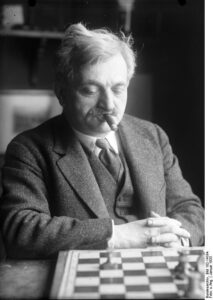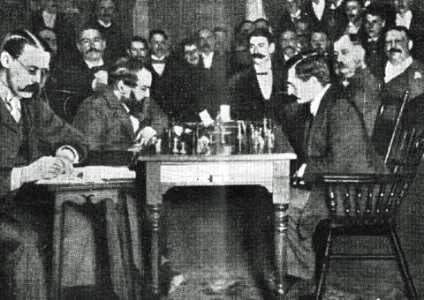When you find a good move, look for a better one.
– Emanuel Lasker
Full name: Emanuel Lasker
Born: 24 December 1868
Place of birth: Berlinchen Prussia
Biography
Emanuel Lasker played the world chess championship between 1894 and 1921. He is also famous because he came up with the ideal notion concept in mathematics.

Emanuel Lasker was a Jew who was born in Prussia, a town located in Brandenburg. His father’s name is Adolf Lasker, and his mother’s name is Rosalie Israelssohn. Lasker’s father worked in the central function of the synagogue. Emanuel had an older sibling whose name was Berthold. They both went to school in Berlin, where Lasker trained to be a chess player at eleven years. Lasker played chess with no motive to make some earning during his teenage years. Even so, he received some payments. Emanuel’s chess trainer was his brother Berthold who studied medicine.
Emanuel Lasker got his parents worried. This is because they felt that he was dedicating much time to chess compared to his studies. As a result, they decided to transfer him from the school. They did so to deviate him from playing chess. Besides, he had more influence from his headteacher. His headteacher presided over the local chess club.
Additionally, the chess champion was also Lasker’s mathematics teacher. Emanuel flourished even more in the chess championship. He also did well in mathematics because he received support from his teachers.
Early Life
Lasker emerged to be the top ten chess player in the year 1921. Lasker also competed with William Steinitz. William accepted defeat in 1894. Later on, Lasker also competed with Frank Marshall, and he won against him.
Although Emanuel was a renowned chess player, he decided to retire after the First World War. Lasker’s talent is notable, where he managed to take the third position in 1935. He competed with modernized chess players younger than him.
Lasker’s Playing Style
Emanuel Lasker incorporated Steinitz’s theory in playing chess.[1] Moreover, he was witty in winning against his opponents. There is a time when Lasker considered taking poor positions. He did this while competing against Tarrasch, and he won. Lasker believed that his psychological intelligence was enough skill in playing chess. He made moves that no one could believe were enough to make him win the game, but he still won.
Lasker played the Albin Countergambit opening and one of the variations we now know, called the Lasker Trap was named after Emanuel Lasker.
Notable Games
Lasker earned his title as a Master of Chess when he won a competition held in Berlin. He became more famous when he won another chess competition. This happened a month after the first win at Hauptturnier. Emanuel’s fame did not come without a downfall. Such is because his opponent challenged him at the Amsterdam tournament.[2]
Nonetheless, Lasker’s judges complimented him for his remarkable intelligence and enthusiasm for chess. Emanuel Lasker also wrote mathematical books. His psychological intelligence steered his writing.
Lasker vs Steinitz

Between 1891 and 1892, Lasker spent his time in England. He had an opportunity to compete with renowned chess players in England. Emanuel would not allow anyone to defeat him. When he moved to the United States in 1893, he did not relent on emerging the winner. Lasker had a chance to compete with the best Chess champion known as the father of Chess himself, Wilhelm Steinitz. The reason why he had the opportunity is that he had won so many times. The two did compete between 15 March 1894 and 26 May 1894.
Emanuel emerged as the winner even though some people disputed his win. Some people argued that Wilhelm was old and not fit to compete with Lasker.
Later the following year, after Lasker’s great win, he fell sick. It took him almost a year to recover. During this period, Lasker did not play chess. He was under his elder brother’s care until 1895. When he recovered, he competed in the Hastings championship and emerged number three. People called the tournament that Lasker engaged in the game of the 19th century. Lasker also engaged in teaching people how to play chess in Germany. He also wrote a book entitled ‘Common Sense of Chess.’ The book received a German-language publication. Moreover, there was an English translation of the same book after one year.
Even though Lasker was in his 60s, he continued to play chess often. He considered competing at the Nuremberg chess competition in 1895, and he won. Furthermore, Emanuel also won in the Steinitz chess competition, where he won in ten games. Lasker was famous for winning in the following games, which he played in London and Paris. Emanuel spent most of his time in his 60, to improve on mathematics. During this time, he wrote his first doctorate thesis with the help of Max Noether. The title of his thesis was Uber Reihen auf der Convergenzgrenze.[3] One can conclude that Lasker took an interest in mathematics as much as he liked playing chess. The reason for this is that he introduced algebraic concepts in playing chess. He also devised games relating to mathematical concepts.
In 1902, Lasker engaged in a chess competition with Frank Marshall. Emanuel did not win in this competition. Thus, his opponent Marshall had the opportunity to proceed to the world championship. Besides, Lasker devised a way to block Marshall. Thus, Marshall lost the chance to proceed to the world championship. Lasker proceeded for the completion because he had more barkers compares to Marshall.
You should note that Lasker established a family later on. This shows that he also focused in his social life. He also moved from one country to another while advancing in his career. Besides, his wife fell sick, and as a result, they could not travel any longer. Lasker spent the rest of his lifetime lecturing in New York in 1937.
Emanuel Lasker spent a more significant part of his life playing Chess. This is evident because he started playing chess at the tender age of thirteen. Moreover, we see him devoting most of his time to playing chess through the help of his brother and his teachers. He was also ready to compete with well-known chess players worldwide and emerged to be a winner. His zeal in playing chess also enabled him to come up with mathematical notions. Note that his concepts were acceptable worldwide.

